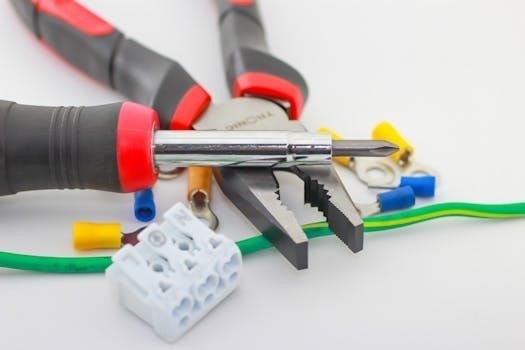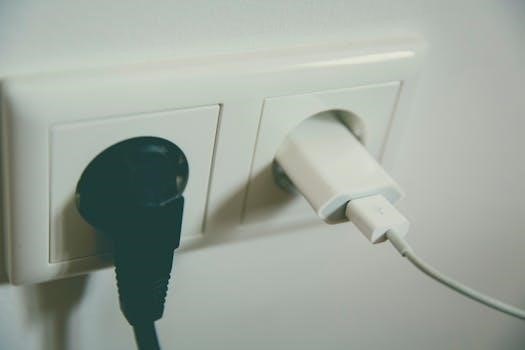
Electrical Wire Color Code Chart PDF⁚ An Overview
Electrical wire color code charts are essential tools for electricians and DIYers. These charts provide a standardized way to identify wires, ensuring safety and efficiency. PDF versions offer convenient access to this information, simplifying electrical work.
Importance of Standardized Color Codes
Standardized color codes in electrical wiring are crucial for safety and efficiency. These codes allow electricians and technicians to quickly identify the function of each wire, reducing the risk of electrical shock and preventing wiring errors. Adhering to color codes simplifies maintenance and troubleshooting, saving time and resources.
Without standardized color codes, identifying wires would be a complex and time-consuming process, increasing the potential for dangerous mistakes. Color coding ensures consistency across different installations, making it easier for anyone working on the system to understand the wiring layout. This is particularly important in complex electrical systems where multiple circuits are involved.
Furthermore, standardized color codes facilitate compliance with electrical safety regulations and industry best practices. By using the correct color for each wire, electricians can demonstrate that their work meets safety standards and minimize the risk of accidents or equipment damage.

North American Electrical Wiring Color Codes
North American electrical wiring follows specific color codes for safety. These codes differentiate hot, neutral, and ground wires. Understanding these color conventions is crucial for safe and correct wiring practices in the region.
Hot (Live) Wire Colors
In North American electrical systems, hot wires, which carry electrical current from the power source, are typically identified by specific colors. The most common colors for hot wires are black and red. Black is generally used for the main hot wire in a 120V circuit. Red often indicates a second hot wire in a 240V circuit or a switch leg. Other colors, such as blue and yellow, are sometimes used for hot wires, particularly in switch loops or multi-wire branch circuits.
It’s crucial to always verify the wiring configuration with a voltage tester, even when the wires are color-coded, to ensure safety and prevent electrical shock. Proper identification and handling of hot wires are paramount for safe electrical work. These color conventions help electricians quickly recognize and manage these wires, contributing to efficient and safe installations.
Neutral Wire Color
The neutral wire in North American electrical systems is universally identified by the color white or gray. This wire provides a return path for the electrical current back to the source, completing the circuit. The neutral wire is typically connected to the ground at the service panel, providing a reference point of zero voltage.
Using white or gray consistently for neutral wires ensures that electricians can easily identify and work with these wires safely. It’s essential to never use white or gray wires for hot or live conductors, as this could lead to dangerous situations and electrical hazards. Always double-check with a voltage tester to confirm the wire’s function before working on any electrical circuit. Proper identification of the neutral wire is critical for maintaining a safe and functional electrical system.
Ground Wire Color
The ground wire in North American electrical systems plays a crucial role in safety by providing a path for stray electrical current to return to the ground, minimizing the risk of electric shock. Typically, the ground wire is identified by the color green or bare copper. The green wire may also have a yellow stripe.
The ground wire is connected to the grounding system of a building, ensuring that any fault current is safely diverted. It’s imperative to never use green or bare copper wires for any other purpose than grounding. Misidentifying the ground wire can lead to hazardous conditions and compromise the safety of the electrical system. Always verify the wire’s function with a multimeter before undertaking any electrical work. Proper grounding is essential for protecting people and equipment from electrical faults.

International Electrical Wiring Color Codes
International electrical wiring color codes vary by region, impacting safety and compliance. The IEC standards aim to harmonize these codes. Understanding these differences is crucial for electricians working across borders to ensure correct and safe installations.
Harmonized Color Coding (IEC)
The International Electrotechnical Commission (IEC) aims to standardize electrical wiring color codes globally, promoting safety and reducing confusion. The IEC 60446 standard defines colors for identifying conductors, including live, neutral, and earth wires.
Harmonization simplifies electrical work for international projects. It ensures consistency in wiring practices, minimizing risks associated with misidentification. The IEC color codes are widely adopted in Europe and other regions, though variations persist.
Key colors include brown for live, blue for neutral, and green/yellow for earth. Understanding IEC standards is crucial for electricians working with international systems. Color code charts are valuable resources for compliance.
Specific Applications and Wire Types
Electrical wire color codes vary based on applications and wire types. Understanding these specific codes is crucial for safety and proper installation. Paired cables and other specialized wiring systems have unique color conventions.
Color Codes for Paired Cables (e.g., Telephone)
Color codes for paired cables, like those used in telephone wiring, follow specific standards such as DIN 47100. These standards ensure clear identification of each wire within the pair, which aids in proper connection and troubleshooting. Typically, paired cables use a combination of base colors and stripes to differentiate each conductor. For example, a common combination includes white with blue, white with orange, and so on.
These color combinations repeat after a certain number of pairs, usually around 23 or 25, and may include colored binders to separate groups of wires. This standardization is vital for maintaining consistency and preventing errors during installation and maintenance. Accurate color coding helps technicians quickly identify and connect the correct wires, saving time and reducing the risk of miswiring.

Resources for Electrical Wire Color Code Charts
Many online resources offer electrical wire color code charts in PDF format. These charts are readily available from electrical suppliers, manufacturers, and educational websites, providing easy access to essential wiring information.
Availability of PDF Charts
Finding electrical wire color code charts in PDF format is generally straightforward, thanks to their widespread availability online. Numerous websites belonging to electrical component suppliers, wiring manufacturers, and educational institutions offer these charts as free downloads. These PDF charts are designed for easy accessibility and can be readily printed or viewed on digital devices, making them convenient for both on-site reference and study.
Moreover, many electrical safety organizations and regulatory bodies also provide downloadable PDF charts, ensuring adherence to standardized color coding practices. These charts often include detailed explanations and illustrations, catering to professionals and hobbyists alike, and aiding in safe electrical installations and repairs.

Safety and Best Practices
Adhering to electrical wire color codes is paramount for safety. Using the correct codes prevents accidents and ensures proper function. Regular reference to a PDF chart during electrical work is a best practice.
Adherence to Color Codes for Safety and Efficiency
Following electrical wire color codes is not merely a suggestion; it’s a critical safety measure. Consistent adherence ensures that anyone working on the system can quickly and accurately identify wires, reducing the risk of electrical shock or damage. The use of a readily available PDF chart promotes best practices by providing a clear reference for identifying line, neutral, and ground wires.
This practice streamlines maintenance and troubleshooting, saving valuable time and resources. Proper identification prevents accidental connections that could lead to short circuits, fires, or equipment failure. By consistently using a color code chart, electricians and DIYers can create a safer and more efficient environment for electrical work, benefiting both the individual and the overall system. Neglecting these standards introduces unnecessary risks and compromises the integrity of the electrical installation.